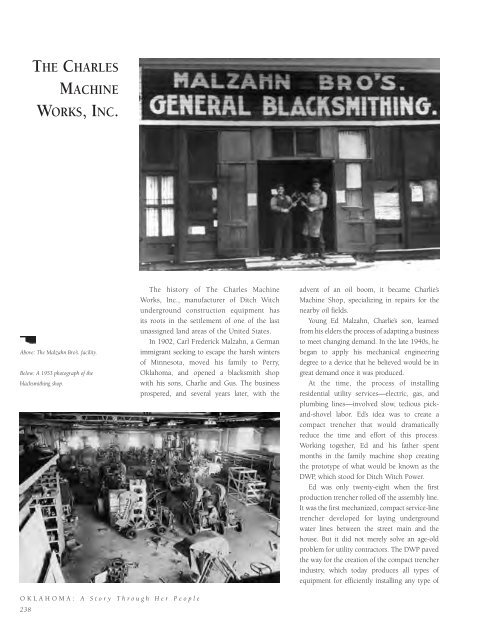Oklahoma: A Story Through Her People
A full-color photography book showcasing Oklahoma paired with the histories of companies, institutions, and organizations that have made the state great.
A full-color photography book showcasing Oklahoma paired with the histories of companies, institutions, and organizations that have made the state great.
Create successful ePaper yourself
Turn your PDF publications into a flip-book with our unique Google optimized e-Paper software.
THE CHARLES<br />
MACHINE<br />
WORKS, INC.<br />
Above: The Malzahn Bro’s. facility.<br />
Below: A 1953 photograph of the<br />
blacksmithing shop.<br />
The history of The Charles Machine<br />
Works, Inc., manufacturer of Ditch Witch<br />
underground construction equipment has<br />
its roots in the settlement of one of the last<br />
unassigned land areas of the United States.<br />
In 1902, Carl Frederick Malzahn, a German<br />
immigrant seeking to escape the harsh winters<br />
of Minnesota, moved his family to Perry,<br />
<strong>Oklahoma</strong>, and opened a blacksmith shop<br />
with his sons, Charlie and Gus. The business<br />
prospered, and several years later, with the<br />
advent of an oil boom, it became Charlie’s<br />
Machine Shop, specializing in repairs for the<br />
nearby oil fields.<br />
Young Ed Malzahn, Charlie’s son, learned<br />
from his elders the process of adapting a business<br />
to meet changing demand. In the late 1940s, he<br />
began to apply his mechanical engineering<br />
degree to a device that he believed would be in<br />
great demand once it was produced.<br />
At the time, the process of installing<br />
residential utility services—electric, gas, and<br />
plumbing lines—involved slow, tedious pickand-shovel<br />
labor. Ed’s idea was to create a<br />
compact trencher that would dramatically<br />
reduce the time and effort of this process.<br />
Working together, Ed and his father spent<br />
months in the family machine shop creating<br />
the prototype of what would be known as the<br />
DWP, which stood for Ditch Witch Power.<br />
Ed was only twenty-eight when the first<br />
production trencher rolled off the assembly line.<br />
It was the first mechanized, compact service-line<br />
trencher developed for laying underground<br />
water lines between the street main and the<br />
house. But it did not merely solve an age-old<br />
problem for utility contractors. The DWP paved<br />
the way for the creation of the compact trencher<br />
industry, which today produces all types of<br />
equipment for efficiently installing any type of<br />
O K L A H O M A : A S t o r y T h r o u g h H e r P e o p l e<br />
238
















